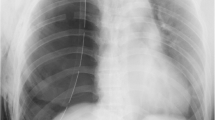Abstract
Carbon dioxide can extravasate from the abdominal cavity during insufflation and result in pneumomediastinum, pneumothorax, and subcutaneous emphysema. We report a case of unilateral pneumothorax with pneumomediastinum and subcutaneous emphysema after laparoscopic extraperitoneal bilateral inguinal hernia repair. Additionally, we discuss the pathophysiology, diagnostic work-up, and management of this malady. Because of the natural resolution of CO2 pneumothoraces, observation for asymptomatic patients is appropriate, whereas tube thoracostomy should be reserved for symptomatic patients. It is utmost importance to determine the etiology of gas extravastion and consider other complications such as airway or esophageal injury or pulmonary barotrauma.
Similar content being viewed by others
Author information
Authors and Affiliations
Rights and permissions
About this article
Cite this article
Hagopian, E.J., Steichen, F.M., Lee, K.F. et al. Gas extravasation complicating laparoscopic extraperitoneal inguinal hernia repair. Surg Endosc 15, 324 (2001). https://doi.org/10.1007/s004640040039
Received:
Accepted:
Issue Date:
DOI: https://doi.org/10.1007/s004640040039




